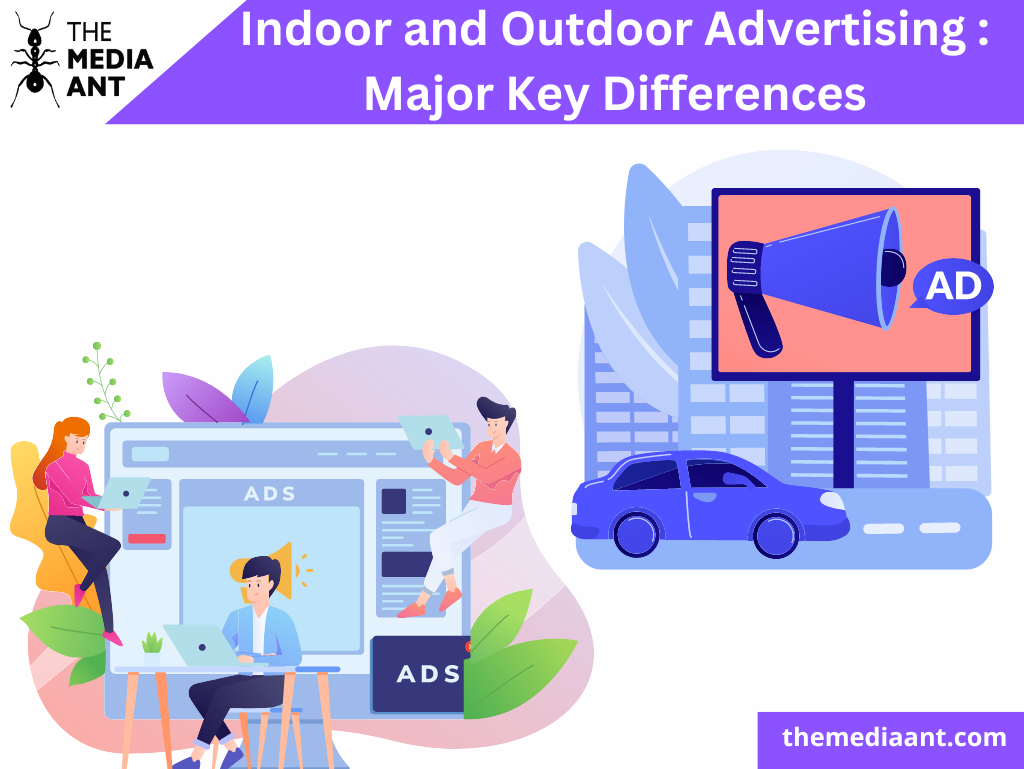Advertising has become an integral part of businesses as it helps them to reach out to their target audience effectively. When it comes to advertising, there are two major categories – indoor advertising and outdoor advertising. Both of these categories have their own set of advantages and disadvantages, and businesses need to understand the differences between them to make the right decision. In this article, we will discuss the major key differences between indoor and outdoor advertising, their pros and cons, and which type of advertising is suitable for which business.
What is Outdoor Advertising?

Outdoor advertising is a type of advertising that utilizes different media channels displayed in outdoor settings such as billboards, posters, transit ads, bus shelter ads, and neon sign boards, among others. This form of advertising is commonly referred to as out-of-home advertising or OOH advertising as it targets consumers who are outside their homes.
Outdoor advertising can be placed almost anywhere as long as it is legally allowed. This advertising method has been popular for decades, and with the emergence of digital out-of-home advertising, it has become even more prevalent in recent times. Outdoor advertising remains valuable for businesses looking to reach a wider audience.
What is Indoor Advertising?

Indoor advertising, as the name suggests, is a form of advertising that is displayed indoors. It is a type of out-of-home advertising that targets consumers who are inside buildings such as shopping malls, airports, transit stations, movie theaters, and more. The goal of indoor advertising is to reach a captive audience while they are engaged in leisure or commerce activities.
Indoor advertising can take various forms, including posters, digital displays, kiosks, and product displays. It is a cost-effective way for businesses to increase brand awareness, promote their products or services, and drive foot traffic to their stores.
Indoor and Outdoor Advertising Key Differences
- Audience Reach: Indoor targets captive audiences; outdoor targets broader passersby.
- Exposure Time: Indoor ads have longer exposure; outdoor ads need to grab attention quickly.
- Environmental Factors: Outdoor ads face weather and lighting challenges; indoor ads have controlled environments.
- Ad Size and Format: Outdoor ads are often large for visibility; indoor ads vary in size and format.
- Engagement Opportunities: Indoor ads offer more direct calls to action; outdoor ads focus on brand awareness.
Types of Outdoor Advertising
Outdoor advertising is a vast and diverse field, encompassing many different types of media options that can be used to display advertising messages to a wide audience. There are many different types of Outdoor advertising and they can be broadly classified into four main categories:
- Hoardings
- Street furniture advertising
- Transit advertising
- Alternative/non-traditional outdoor advertising.
Hoardings
Hoardings are typically large, eye-catching signs that are placed in high-traffic areas such as along highways or near shopping centers. They are effective at creating brand awareness and are always visible, 24×7.
Transit Advertising
Transit advertising refers to ads that are placed inside or on public transportation or in transportation precincts. This includes auto branding, cab branding, bus shelter advertising, and more. Transit ads are usually less expensive than other types of outdoor advertising and allow advertisers to reach a select segment of the population.
Street Furniture Advertising
Street furniture advertising refers to ads placed on street-level urban media such as news racks, mall kiosks, park benches, and telephone booths. These ads are at eye level for pedestrians and can be highly attention-grabbing, especially for those waiting for public transportation.
Non- traditional Outdoor Advertising
Non-traditional outdoor advertising refers to various creative media options such as walking billboards, pole kiosks, hot-air balloons, sailboats, and LED screens. These options allow advertisers to think outside the box and create unique, eye-catching ads that can stand out in a crowded advertising landscape.
Types of Indoor Advertising
Indoor advertising refers to all media options that are displayed inside buildings, such as malls, stores, airports, hospitals, and other public places. This form of advertising aims to reach consumers when they are inside these establishments.
There are various types of indoor advertising, which can be broadly categorized into four main categories:
- Point of Sale Advertising
- Digital Signage
- Indoor Billboards
- Instore Media
Point of Sale Advertising
Point of sale advertising refers to advertising materials placed at the point where a purchase is made, such as on shelves or near the checkout counters in stores. This type of advertising is meant to encourage impulse buying and increase sales.
Digital Signage
Digital signage involves the use of screens and displays to showcase advertising content in public spaces. These can be standalone screens or video walls placed in lobbies, waiting rooms, and other public areas.
Indoor Billboards
Indoor billboards, also known as indoor posters, are displayed in high-traffic areas inside buildings, such as elevators, staircases, and hallways. They are an effective way to reach a captive audience, such as office workers or hospital patients.
In-Store Media
In-store media includes advertising materials such as floor graphics, window clings, and banners, placed inside stores to attract the attention of shoppers. These ads can be placed throughout the store, including in dressing rooms and on shopping carts.
Indoor advertising is a powerful way to reach consumers when they are inside buildings. It offers a captive audience, which can be targeted with customized and engaging ads that are designed to boost sales and drive brand awareness.
How to Place Outdoor and Indoor Ads?
Placing advertisements is a crucial part of any marketing campaign, and knowing how to effectively place outdoor and indoor ads can make all the difference in their success. Here are some steps to consider when placing outdoor and indoor ads:
Outdoor Advertising:
- Identify the target audience and determine the best location to reach them.
- Choose the appropriate type of outdoor ad based on the target audience and location.
- Consider the size and design of the ad to make it visually appealing and memorable.
- Check the legal and regulatory requirements for placing outdoor ads in the chosen location.
- Negotiate with the outdoor advertising company and finalize the contract for the placement of the ad.
Indoor Advertising:
- Determine the target audience and the most effective location to reach them indoors.
- Choose the type of indoor ad based on the location and target audience, such as in-store displays, digital signage, or floor graphics.
- Create a visually attractive design that is consistent with the brand identity and messaging.
- Determine the most effective placement within the location, such as near the entrance or in high-traffic areas.
- Negotiate with the indoor advertising company or the location owner and finalize the contract for ad placement.
By following these steps and carefully considering the target audience and location, advertisers can place effective outdoor and indoor ads that will reach their intended audience and achieve their marketing goals.
Managing outdoor and indoor advertising campaigns can be a complex and time-consuming task. To ensure a successful campaign, it is recommended to work with an experienced advertising agency that can guide you through the entire process. The Media Ant is a reputable advertising agency with over 10+ years of experience in the industry.
By choosing The Media Ant, you can save yourself the stress of coordinating with various vendors and media channels. The agency provides end-to-end services, including campaign planning, media buying, and campaign execution. Their team of experts can help you identify the best advertising options based on your budget, target audience, and campaign goals.
Outdoor Advertising and Indoor Advertising – Which one to opt for?

When it comes to advertising, both outdoor and indoor advertising have their own advantages and disadvantages. Choosing the right type of advertising depends on your advertising goals and target audience.
If you want to reach a wider audience and create brand awareness, then outdoor advertising is the way to go. Outdoor advertising is visible to a large number of people at all times of the day and can be very effective in creating a strong brand presence. However, it can be expensive and may not be suitable for all types of products or services.
On the other hand, Indoor advertising is more targeted and can be more effective in reaching a specific audience. Indoor advertising can be placed in areas where your target audience is more likely to be, such as malls, airports, or universities. This type of advertising can be more cost-effective than outdoor advertising but may not have the same reach as outdoor advertising.
Ultimately, the decision between outdoor and indoor advertising will depend on your specific advertising goals, budget, and target audience. It is important to carefully consider these factors before making a decision and to work with an experienced advertising agency to ensure that your advertising campaign is effective and successful.
Top Indoor & Outdoor Advertising Agency
An advertiser looking to find either an outdoor or an indoor ad agency might never run short of options because of the high availability of advertising agencies in almost every city in India.
The real struggle comes when one has to pick the best among thousands of available options.
Why is The Media Ant different from other ad agencies?
With The Media Ant, your brand is put in the best hands as we strive every day to provide top-notch outdoor/indoor advertising services to our clients. We have a dedicated team to look into your every need and provide you with the best advertising rates.
Whether it’s campaign planning or monitoring, our team will take care of you at every step of the way so that you don’t have to worry about anything. We make your outdoor advertising journey seamless from inception to the end.
With more than 10 media options to advertise on and thousands of categories to choose from, you will never run out of options with The Media Ant.
Not only this, we make sure you get the best updates rates no matter which vertical you want to advertise on.
Connect with us at Help@themediaant.com and begin your advertising journey the right way!
FAQs Related to Indoor & Outdoor Advertising
What is indoor and outdoor advertisement?
Indoor advertisement refers to the type of advertisement that is displayed inside a building or a confined space, such as malls, airports, cinemas, and public transport vehicles.
Outdoor advertisement refers to the type of advertisement that is displayed outside, in open spaces like billboards, bus shelters, and on vehicles.
Which is a form of indoor advertising?
A form of indoor advertising is digital signage, which includes the use of LCD, LED, or projection screens to display advertisements in various indoor environments like malls, offices, and airports.
What is indoor media?
Indoor media refers to the various types of media available for advertising inside a building or a confined space. This includes digital screens, banners, posters, and flyers that can be used to promote products or services to a captive audience.
What is indoor advertising called?
Indoor advertising is also called indoor media advertising or indoor marketing.
What is an example of outdoor advertising?
An example of outdoor advertising is a billboard, which is a large advertising structure that is typically placed in high-traffic areas like highways or busy city streets to capture the attention of drivers and pedestrians.






Thanks for sharing informative article